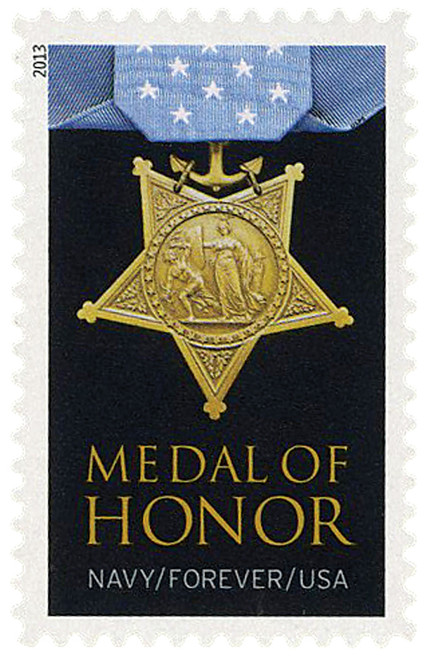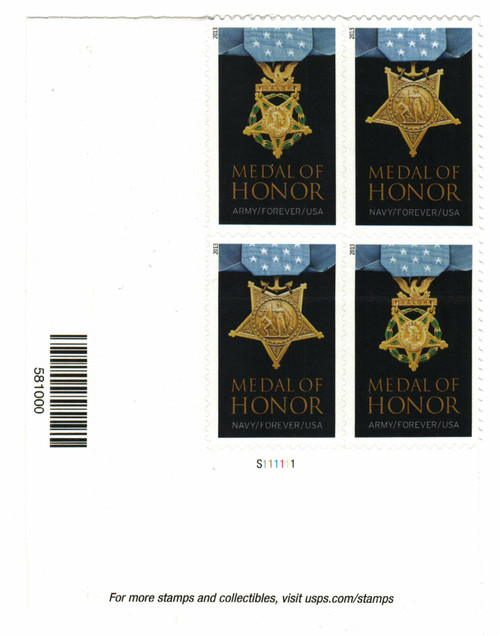
# 4822-23f - 2013 First-Class Forever Stamp - Imperforate Medal of Honor: World War II
U.S. # 4822-23f Imperforate
2014 47¢ Medal of Honor: Korean War
One hundred forty-six Medals of Honor have been awarded to servicemen for their gallant actions in Korea between 1950 and 1953. Of these, the majority fought in the Marines or the Army. Four servicemen honored were in the Air Force.
The Congressional Award was introduced in December 1861 for Navy officers, seamen, landsmen, and marines who “distinguish[ed] themselves by their gallantry.” An Army medal followed soon after in February 1862. The advent of flight in the 20th century led to the Army Air Corps, but the 46 airmen earning the Medal of Honor in WWI, WWII, and Korea were all recognized with Army medals.
It was not until long after the creation of the U.S. Air Force in 1947 that a separate and distinct medal was contemplated to recognize airmen. In 1956, a new medal was authorized and in 1965 its design was approved. Since 1965, 14 airmen have received the distinction.
Sadly, the majority of Medals of Honor are bestowed posthumously. Though gone, these war heroes are not – and will never be – forgotten. Today, the names of all Medal of Honor recipients from the Korean War and all other military conflicts are memorialized at the Congressional Medal of Honor Museum in Mt. Pleasant, South Carolina.
U.S. Troops Committed To Korean War
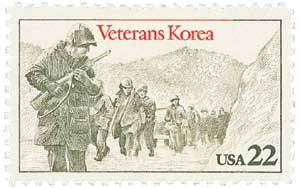
On June 27, 1950, President Harry Truman announced that America would send troops to aid South Korea.
As World War II came to an end, the Allied leaders discussed the fate of the Japanese Empire. Korea had been an imperial colony since 1910 and was one of the areas under consideration. At a meeting in Cairo in 1943, it was decided the U.S. would occupy the southern part of the Korean peninsula, and the Soviet Union would rule the north. Two young U.S. colonels chose the latitude line 38 degrees north of the equator as the dividing line. The occupation was supposed to be temporary, and the ultimate goal was for Korea to be “free and independent in due course,” according to the Cairo conference.
The U.S. and Soviet Union began their occupation in 1945. The United Nations planned to oversee elections in 1947, with the hopes of unifying the country. Instead, the Soviet Union supported Kim Il-sung as leader of the Democratic People’s Republic of Korea (DPRK) and refused to hold elections. The U.S. helped elect Syngman Rhee as president of the new Republic of Korea (ROK). Both men wanted a unified nation, but their ideas about the government of Korea differed greatly. Kim had trained with Soviet troops during the war and was sympathetic to communism. Rhee, the country’s exiled leader, was educated in America and was against communism.
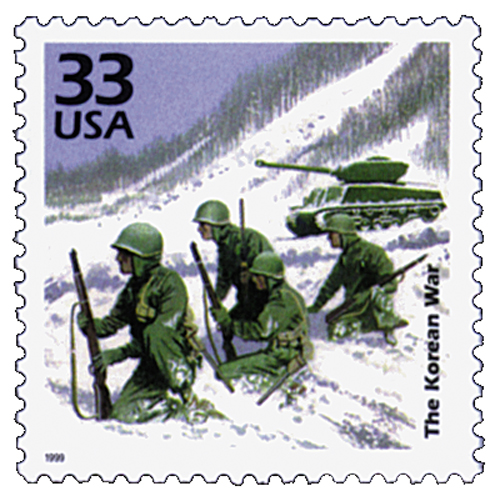
In 1949, the U.S. and Soviet Union withdrew their militaries from the region, but left advisors. Negotiations continued in an effort to unify the nation as the new Korean governments skirmished across the 38th parallel. Members of the DPRK Army were well trained and supplied by the Soviet Union and Communist China. In contrast, the southern ROK forces were poorly equipped and without adequate training.
On June 25, 1950, 75,000 North Korean soldiers poured across the 38th Parallel to begin their takeover of the entire peninsula. Soviet tanks and heavy artillery supported them. The ROK troops had no tanks or weapons to combat tank attacks. Within days, they were pushed south and Seoul, the capital, fell to the DPRK forces. ROK soldiers retreated or defected to the Northern army.
Fearing the invasion would advance the spread of communism worldwide, the United Nations Security Council condemned North Korea’s actions and called for a ceasefire. On June 27, 1950, U.S. President Harry Truman addressed the nation stating that he would send U.S. air and naval forces to help South Korea fight the communist threat. President Truman said, “I felt certain that if South Korea was allowed to fall, Communist leaders would be emboldened to override nations closer to our shores.” While it wasn’t a declaration of war, Congress voted to extend the draft and call up reservists. The Security Council met the following day and approved the use of force against North Korea. And on June 30 Truman agreed to send ground troops.
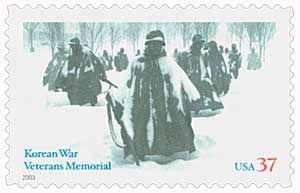
The U.S. committed the majority of forces in the U.N. command and led the operation. America’s military had been greatly reduced after World War II because of budget cuts and an emphasis on funding research on nuclear bombs. The military had to be strengthened and reorganized quickly to effectively fight a war.
U.S. forces stationed in Japan were the first to go to Korea. The 21st Infantry Regiment of the 24th Infantry Division was considered the most combat-ready. A task force of 400 infantry supported by about 130 men from an artillery battery was the first to land in Korea. Most of the soldiers and officers had no combat experience, and their weapons were inferior to those of the North Koreans. The mission of Task Force Smith was to hold the enemy as far north as they could for as long as possible. This would allow more time to get men and equipment into the southeastern corner of the nation where the U.N. command was setting up a defensive perimeter. On July 5, the first battle between the U.S. and North Korea began. Though it was clearly a victory for the North, Task Force Smith slowed down the much larger force for seven hours.
This action was followed by similar battles, as the U.N. forces retreated. By the time both sides arrived near Pusan, a deep-water port on the southern tip of Korea, U.N. defenses were built and soldiers and equipment had arrived. The defense of the Pusan Perimeter began on August 4 and lasted more than a month. On September 16, U.N. forces broke through the enemy’s line and began pushing them back toward the 38th Parallel.
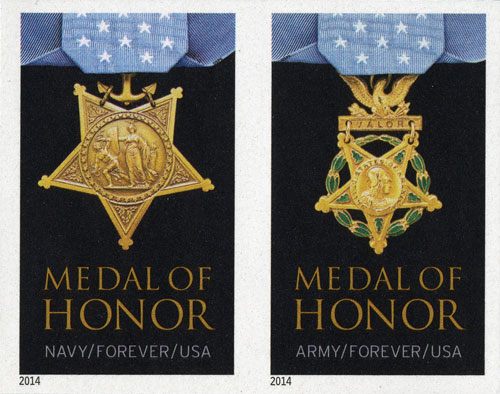
The momentum of the war changed, and the U.S.-backed army retook South Korea and crossed the 38th Parallel. During the course of the fighting, the objective of the war changed from containing the Communists in North Korea to defeating them and liberating the nation. It looked like the war would be over quickly, and a united Korea would be free of communism.
After recapturing South Korea, General MacArthur, commander of the U.N. army, was given permission to proceed to the northern border at the Yalu River. Communist China, on the other side of the river, called this movement “armed aggression against Chinese territory.” Leader Mao Zedong warned against crossing the 38th Parallel, threatening to intervene on North Korea’s behalf.
U.S. and U.N. leaders did not take Mao’s threat seriously and did not prepare for combat against the large People’s Volunteer Army (PVA). The Chinese offensive began on October 25 and took the U.N. command by surprise. After a long, cold winter of fighting, the war was taking place along the 38th Parallel once again.
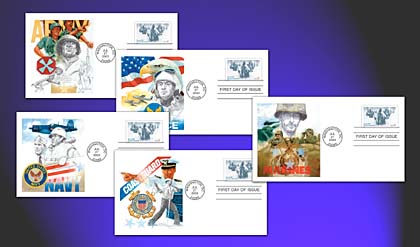
During this time, General MacArthur supported invading China to destroy supply depots. In a letter, he wrote, “There is no substitute for victory,” and discussed using an atom bomb against Chinese forces. The general had repeatedly gone against his orders from President Truman, and on April 11, 1951, MacArthur was relieved of his duties. General Matthew Ridgway replaced him.
For the remainder of the war, the U.N. command and PVA were in a stalemate. Negotiations began on July 10, 1951, in an effort to end the war. Both sides agreed to a ceasefire, but the issue of prisoners of war caused the talks to stall. China and North Korea wanted all prisoners to be returned to their home country. The U.S. and its allies wanted prisoners to be allowed to choose whether they wanted to go back or remain in the country in which they were held captive.
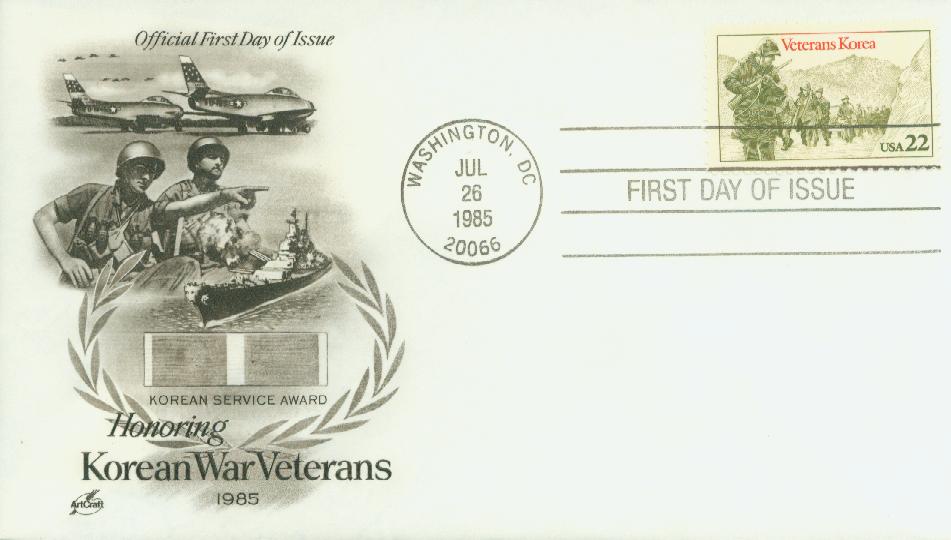
The armistice was finally signed on July 27, 1953. Both sides agreed to let prisoners decide where they wanted to live. Former POWs had sixty days to return to their home country. The country was divided along a line close to the 38th Parallel, called the Korean Demilitarized Zone. Today, the 2.5-mile-wide border is still the most heavily guarded border in the world.
Following the format of the 2013 World War II Medal of Honor issue, the 2014 stamps honor the 145 recipients of the award from the Korean War. Photos of the last 13 living recipients were pictured on the front of the prestige folio, a new stamp format, with the names of all those rewarded printed in the back. The stamps picture the Army and Navy versions of the Medal of Honor, photographed by Richard Frasier.
Value: 47¢ 1-ounce first-class letter rate
Issued: July 26, 2014
First Day City: Washington, D.C. at the Arlington National Cemetery’s Amphitheater
Type of Stamp: Commemorative
Method: Offset printing in prestige folios of 20
Perforation: Imperforate
Self-Adhesive
The first stamp to feature the Medal of Honor (#2045) was issued in 1983. Beginning in 2013, the U.S.P.S. began issuing stamps honoring Medal of Honor Recipients from World War II (#4822-23), the Korean War (#4822a-23a), and the Vietnam War (#4988a).
Other U.S. issues honoring the Korean War include #2152 (Korean War Veterans), #3187e (from the Celebrate the Century pane), and #3803 (Korean War Veterans Memorial).
Scarce Modern Imperforates
The modern imperforate stamps are one of the hottest stories around. In 2012, the U.S. Postal Service released some issues as press sheets. The sheets with die cut perforations were issued in limited quantities.
To the surprise of many collectors, officials then issued a small number of press sheets without perforations. The uncut sheets were only available in Kansas City, Missouri, yet most sold out immediately. In an instant, the imperforate stamp sheets became modern rarities. For example, only 75,000 Baseball All-Star se-tenant sheets were issued compared to 118,000 Bugs Bunny sheets with the 10th stamp imperforate.
In a controversial move, the editors of Scott Catalogue announced they would not list or give numbers to these stamps because they did not fit Scott guidelines. This decision was strongly debated since the imperforate stamps are valid for postage. They eventually decided to give the stamps minor numbers and have continued issuing imperforates in the years since.
Because they were issued in such limited quantities, these scarce modern imperforates can be difficult to find. Luckily Mystic purchased a small number of each imperforate stamp issued so you can add these modern rarities to your collection. Be one of the lucky few – order today.
U.S. # 4822-23f Imperforate
2014 47¢ Medal of Honor: Korean War
One hundred forty-six Medals of Honor have been awarded to servicemen for their gallant actions in Korea between 1950 and 1953. Of these, the majority fought in the Marines or the Army. Four servicemen honored were in the Air Force.
The Congressional Award was introduced in December 1861 for Navy officers, seamen, landsmen, and marines who “distinguish[ed] themselves by their gallantry.” An Army medal followed soon after in February 1862. The advent of flight in the 20th century led to the Army Air Corps, but the 46 airmen earning the Medal of Honor in WWI, WWII, and Korea were all recognized with Army medals.
It was not until long after the creation of the U.S. Air Force in 1947 that a separate and distinct medal was contemplated to recognize airmen. In 1956, a new medal was authorized and in 1965 its design was approved. Since 1965, 14 airmen have received the distinction.
Sadly, the majority of Medals of Honor are bestowed posthumously. Though gone, these war heroes are not – and will never be – forgotten. Today, the names of all Medal of Honor recipients from the Korean War and all other military conflicts are memorialized at the Congressional Medal of Honor Museum in Mt. Pleasant, South Carolina.
U.S. Troops Committed To Korean War

On June 27, 1950, President Harry Truman announced that America would send troops to aid South Korea.
As World War II came to an end, the Allied leaders discussed the fate of the Japanese Empire. Korea had been an imperial colony since 1910 and was one of the areas under consideration. At a meeting in Cairo in 1943, it was decided the U.S. would occupy the southern part of the Korean peninsula, and the Soviet Union would rule the north. Two young U.S. colonels chose the latitude line 38 degrees north of the equator as the dividing line. The occupation was supposed to be temporary, and the ultimate goal was for Korea to be “free and independent in due course,” according to the Cairo conference.
The U.S. and Soviet Union began their occupation in 1945. The United Nations planned to oversee elections in 1947, with the hopes of unifying the country. Instead, the Soviet Union supported Kim Il-sung as leader of the Democratic People’s Republic of Korea (DPRK) and refused to hold elections. The U.S. helped elect Syngman Rhee as president of the new Republic of Korea (ROK). Both men wanted a unified nation, but their ideas about the government of Korea differed greatly. Kim had trained with Soviet troops during the war and was sympathetic to communism. Rhee, the country’s exiled leader, was educated in America and was against communism.

In 1949, the U.S. and Soviet Union withdrew their militaries from the region, but left advisors. Negotiations continued in an effort to unify the nation as the new Korean governments skirmished across the 38th parallel. Members of the DPRK Army were well trained and supplied by the Soviet Union and Communist China. In contrast, the southern ROK forces were poorly equipped and without adequate training.
On June 25, 1950, 75,000 North Korean soldiers poured across the 38th Parallel to begin their takeover of the entire peninsula. Soviet tanks and heavy artillery supported them. The ROK troops had no tanks or weapons to combat tank attacks. Within days, they were pushed south and Seoul, the capital, fell to the DPRK forces. ROK soldiers retreated or defected to the Northern army.
Fearing the invasion would advance the spread of communism worldwide, the United Nations Security Council condemned North Korea’s actions and called for a ceasefire. On June 27, 1950, U.S. President Harry Truman addressed the nation stating that he would send U.S. air and naval forces to help South Korea fight the communist threat. President Truman said, “I felt certain that if South Korea was allowed to fall, Communist leaders would be emboldened to override nations closer to our shores.” While it wasn’t a declaration of war, Congress voted to extend the draft and call up reservists. The Security Council met the following day and approved the use of force against North Korea. And on June 30 Truman agreed to send ground troops.

The U.S. committed the majority of forces in the U.N. command and led the operation. America’s military had been greatly reduced after World War II because of budget cuts and an emphasis on funding research on nuclear bombs. The military had to be strengthened and reorganized quickly to effectively fight a war.
U.S. forces stationed in Japan were the first to go to Korea. The 21st Infantry Regiment of the 24th Infantry Division was considered the most combat-ready. A task force of 400 infantry supported by about 130 men from an artillery battery was the first to land in Korea. Most of the soldiers and officers had no combat experience, and their weapons were inferior to those of the North Koreans. The mission of Task Force Smith was to hold the enemy as far north as they could for as long as possible. This would allow more time to get men and equipment into the southeastern corner of the nation where the U.N. command was setting up a defensive perimeter. On July 5, the first battle between the U.S. and North Korea began. Though it was clearly a victory for the North, Task Force Smith slowed down the much larger force for seven hours.
This action was followed by similar battles, as the U.N. forces retreated. By the time both sides arrived near Pusan, a deep-water port on the southern tip of Korea, U.N. defenses were built and soldiers and equipment had arrived. The defense of the Pusan Perimeter began on August 4 and lasted more than a month. On September 16, U.N. forces broke through the enemy’s line and began pushing them back toward the 38th Parallel.

The momentum of the war changed, and the U.S.-backed army retook South Korea and crossed the 38th Parallel. During the course of the fighting, the objective of the war changed from containing the Communists in North Korea to defeating them and liberating the nation. It looked like the war would be over quickly, and a united Korea would be free of communism.
After recapturing South Korea, General MacArthur, commander of the U.N. army, was given permission to proceed to the northern border at the Yalu River. Communist China, on the other side of the river, called this movement “armed aggression against Chinese territory.” Leader Mao Zedong warned against crossing the 38th Parallel, threatening to intervene on North Korea’s behalf.
U.S. and U.N. leaders did not take Mao’s threat seriously and did not prepare for combat against the large People’s Volunteer Army (PVA). The Chinese offensive began on October 25 and took the U.N. command by surprise. After a long, cold winter of fighting, the war was taking place along the 38th Parallel once again.

During this time, General MacArthur supported invading China to destroy supply depots. In a letter, he wrote, “There is no substitute for victory,” and discussed using an atom bomb against Chinese forces. The general had repeatedly gone against his orders from President Truman, and on April 11, 1951, MacArthur was relieved of his duties. General Matthew Ridgway replaced him.
For the remainder of the war, the U.N. command and PVA were in a stalemate. Negotiations began on July 10, 1951, in an effort to end the war. Both sides agreed to a ceasefire, but the issue of prisoners of war caused the talks to stall. China and North Korea wanted all prisoners to be returned to their home country. The U.S. and its allies wanted prisoners to be allowed to choose whether they wanted to go back or remain in the country in which they were held captive.

The armistice was finally signed on July 27, 1953. Both sides agreed to let prisoners decide where they wanted to live. Former POWs had sixty days to return to their home country. The country was divided along a line close to the 38th Parallel, called the Korean Demilitarized Zone. Today, the 2.5-mile-wide border is still the most heavily guarded border in the world.
Following the format of the 2013 World War II Medal of Honor issue, the 2014 stamps honor the 145 recipients of the award from the Korean War. Photos of the last 13 living recipients were pictured on the front of the prestige folio, a new stamp format, with the names of all those rewarded printed in the back. The stamps picture the Army and Navy versions of the Medal of Honor, photographed by Richard Frasier.
Value: 47¢ 1-ounce first-class letter rate
Issued: July 26, 2014
First Day City: Washington, D.C. at the Arlington National Cemetery’s Amphitheater
Type of Stamp: Commemorative
Method: Offset printing in prestige folios of 20
Perforation: Imperforate
Self-Adhesive
The first stamp to feature the Medal of Honor (#2045) was issued in 1983. Beginning in 2013, the U.S.P.S. began issuing stamps honoring Medal of Honor Recipients from World War II (#4822-23), the Korean War (#4822a-23a), and the Vietnam War (#4988a).
Other U.S. issues honoring the Korean War include #2152 (Korean War Veterans), #3187e (from the Celebrate the Century pane), and #3803 (Korean War Veterans Memorial).
Scarce Modern Imperforates
The modern imperforate stamps are one of the hottest stories around. In 2012, the U.S. Postal Service released some issues as press sheets. The sheets with die cut perforations were issued in limited quantities.
To the surprise of many collectors, officials then issued a small number of press sheets without perforations. The uncut sheets were only available in Kansas City, Missouri, yet most sold out immediately. In an instant, the imperforate stamp sheets became modern rarities. For example, only 75,000 Baseball All-Star se-tenant sheets were issued compared to 118,000 Bugs Bunny sheets with the 10th stamp imperforate.
In a controversial move, the editors of Scott Catalogue announced they would not list or give numbers to these stamps because they did not fit Scott guidelines. This decision was strongly debated since the imperforate stamps are valid for postage. They eventually decided to give the stamps minor numbers and have continued issuing imperforates in the years since.
Because they were issued in such limited quantities, these scarce modern imperforates can be difficult to find. Luckily Mystic purchased a small number of each imperforate stamp issued so you can add these modern rarities to your collection. Be one of the lucky few – order today.









